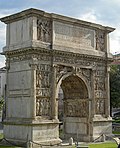 Ruins of Liternum, Lago Patria | |
 | |
| Location | Giugliano in Campania, Province of Naples, Italy |
|---|---|
| Region | Campania |
| Type | Settlement |
| Site notes | |
| Management | Soprintendenza per i Beni Archeologici di Napoli |
| Public access | Yes |
| Website | Sito Archeologico di Liternum (in Italian) |
Liternum was an ancient town of Campania, southern central Italy, near "Patria Lake", on the low sandy coast between Cumae and the mouth of the Volturnus. It was probably once dependent on Cumae. In 194 BC it became a Roman colony. [1] Although Livy records that the town was unsuccessful, [2] excavation reveals a Roman town existed there until the 4th century AD. [3]


